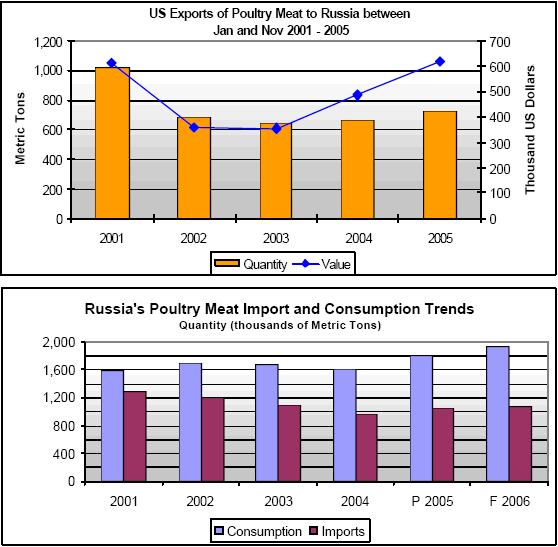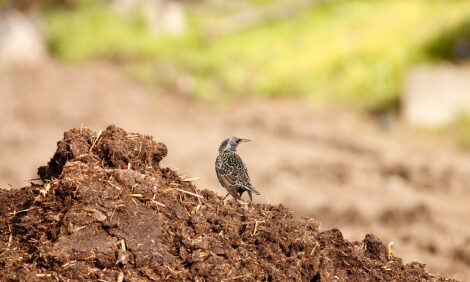



International Egg and Poultry Review
By the USDA's Agricultural Marketing Service - This is a weekly report looking at international developments concerning the poultry industry, this week looking at Russia.
Russia
Meat imports into Russia have come under stricter hygienic control.
Due to the continuing global bird flu crisis and other health scares,
customs officers are clearing imported meat only after it has been
inspected by state experts. The meat, in other words, must now be
inspected by two agencies before it is allowed entrance into Russia.
The agencies are Federal Veterinary and Phytosanitary Oversight
Services and the Federal Service for the Oversight of Consumer
Protection and Welfare. Other preventive measures being taken
concerning poultry include vaccinating all personnel at regional poultry
farms against bird flu and emergency checks at nineteen poultry
farms in Nizhny Novgorod region. Since July, 2005 more than 600,000
domestic fowl have been destroyed in Russia.
Previously shipments of food products were sent directly to Russia
or transshipped through either Western Europe or Baltic and Finnish
ports. The advantage of these ports were greater efficiency, fewer
problemswith loss or damage and overall lower handling costs. Due
to changesin import requirements, shipments have been redirected
to the portsof St. Ptersburg, Novorssisk, Valdivistok and Rostov-on-
Don. However, most products destined for the Russian Far East
(RFE) enter through the ports of Vladivistok, Vostochny, Vanino,
Nakhodka and Magadan. Even though Vostochny is the regions
largest port by volume, the majority of U.S. food exports to the RFE
enter through Vladivostok.
The greater port of St. Petersburg unloads more than 50 percent of all
container shipments to Russia, 12 million tons from January –
November, 2005. The container turnover is estimated to have
increased 45% in 2005 and will reach 1 million TEU (TEU is a 20 foot
container). It is one of the largest ports in the Baltic region and its
turnover exceeds the container traffic of all the Finnish ports combined.
Transit time from the U.S. to St. Petersburg is 20-27 days, depending
on origination, and an additional 4 days shipping by rail to Moscow
for the final destination. Moscow is said to consume 90% of the food
imported by Russia, about $15 billion in 2005.
Plans have been announced for a $280 million investment in the
development of the infrastructure of the port with completion estimated
by 2010. Plans include the construction of five specialized terminals.
The terminals are for containers, refrigerated containers, mineral
fertilizers, bulk cargo and metals (alumina). The container terminal
will be operational by 2008 and will be able to transship 500,000 20
foot containers. The refrigerated terminal will be able to transfer 1.5
million tons of refrigerated goods and will have a special section for
cargo from the United States due to the large volumes of U.S. poultry,
fish and fresh fruits that are the major consignee of the Greater Port
of St. Petersburg. The other terminals will be able to handle 1.2
million tons of alumina and 3 million tons of bulk cargo.
Russia’s reliance on imports underscores the need for safe, reliable
sources of food for its 143 million consumers. High world prices for
oil and natural gas, increases in sovereign credit ratings and stability
in the political situation has caused an overall economic development
and consumer spending boom that is beginning to spread beyond
Moscow and St. Petersburg into the regions. Approximately ninety
percent of food prepared in restaurants and cafes in Western Russia
and forty-four percent of products sold through retail are imported.
From January – November, 2005 Russia imported 729,530 metric
tons of poultry meat from the United States.
As a result of the reliance Russia has on imports, any import bans
placed on exporting countries can affect internal meat prices. For
example, after Russian officials met with Brazilian officials in
December, 2005 concerning several foot and mouth disease
outbreaks, Russian officials announced a one year ban on all beef
and pork products from Mato Grosso do Sul and Parana plus six
month bans on six other nearby states in Brazil. Once Brazilian meat
supplies in storage run low it is expected pork and beef prices to
increase by more than 10 percent in the near term and 15-20 percent
in the long term. During the first nine months of 2005, 50% of all pork
imports and 40% of all beef imports to Russia came from Brazil.
Starting January 20, 2006, Russia has also banned all livestock
products from the Ukraine.
The Agricultural National Priority Project was announced in early
September, 2005 with an aim to increase domestic production of
livestock and dairy products by providing interest free loans to
businesses that will construct and/or modernize livestock farming
facilities. A major aim of the program is to expand the quantity (and
reduce the price of leasing) of pedigree livestock by expanding rural
credit. Livestock is defined as including dairy cattle, swine, beef and
poultry. The loan program started in 2003 that had farmers receiving
3 and 5 year loans with interest tow-thirds funded by the federal budget
will continue.

To view the full report, including tables please click here
Source: USDA's Agricultural Marketing Service - 24th January 2006








